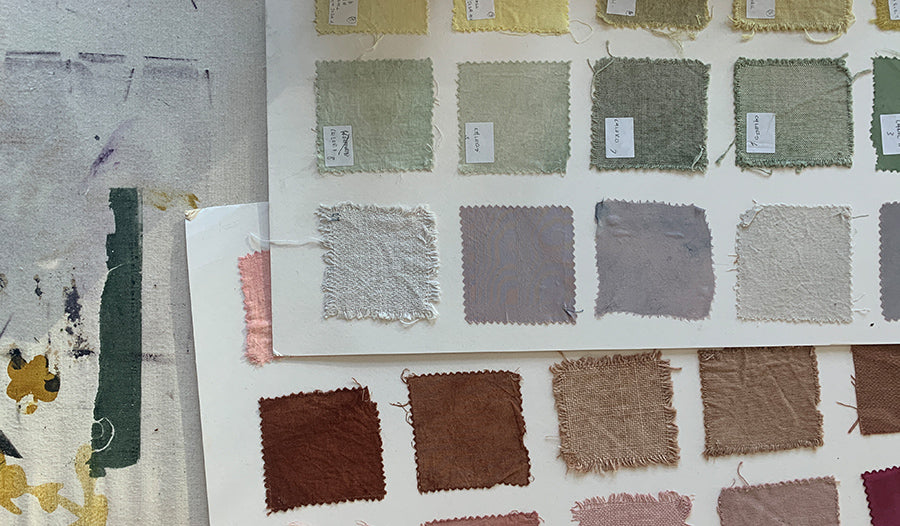
A TEXTILE GARDEN FOR FASHION REVOLUTION
 Image: Natural dye swatches by Kate Turnbull. Photo by Lottie Delamain.
Image: Natural dye swatches by Kate Turnbull. Photo by Lottie Delamain.
Throughout history, plants have played a fundamental role in fashion - as dyes, fibres, floral motifs and in botanical folklore, connecting us to a place, a story or a culture.
While trekking in Northern Vietnam, garden designer Lottie Delamain saw how families grew the plants to make their clothes alongside their vegetables and was fascinated by the close relationship between what they wore and what was growing in their gardens. However in our globalised world, this connection is rapidly being lost.
In May this year, in support of Fashion Revolution, Lottie will create the first-ever garden at the world-famous RHS Chelsea Flower Show solely featuring plants that can be used to make or dye our clothes. A Textile Garden for Fashion Revolution will be part of the new ‘All About Plants’ category alongside several other gardens, supported by Project Giving Back.
 Image: Design for the Textile Garden
Image: Design for the Textile Garden
A Textile Garden for Fashion Revolution provides a unique opportunity to showcase creative possibilities and innovative thinking around how we can use the resources that are literally on our doorsteps to create more sustainable solutions. It will help to re-establish the connection between plants and textiles, reveal the beauty to be found in plant-based dyes and fibres, and sow a seed of curiosity about what we wear.
The garden design is intended to imitate a textile, with planting in distinctive blocks of colour to create the impression of a woven fabric. Plants will be supplied by UK nurseries and growers and will be chosen for their use as fibres or textile dyes in commercial or craft use and the garden will feature a textile installation made entirely from plants by students of Headington School Oxford. Shallow reflective pools represent dye baths, with fabric or fibres soaking in natural dyes, and a series of paved seams will lead through the planting.
 Image: Fashion Revolution Who Made My Clothes initiative. Fashion Revolution week takes place 18th -24th April.
Image: Fashion Revolution Who Made My Clothes initiative. Fashion Revolution week takes place 18th -24th April.
The fashion industry is dominated by synthetic fibres and chemical dyes. Polyester manufacturing is an energy-intensive process, requiring large amounts of water and producing high levels of greenhouse gas emissions, while wastewater emitted from its processing contain volatile substances that can pose a threat to human health. Despite this, Fashion Revolution’s Fashion Transparency Index 2021 found that only a quarter of major brands publish time-bound, measurable targets on reducing the use of textiles deriving from virgin fossil fuels. More than 15,000 chemicals can be used during the textile manufacturing process, from the raw materials through to dyeing and finishing, yet only 30% of brands disclose their commitment to eliminating the use of hazardous chemicals from our clothes.
Co-founder of Fashion Revolution Carry Somers saw the impact our clothing has on the environment first hand two years ago, when she sailed 2000 miles into the South Pacific Gyre on an all-woman scientific research voyage to investigate microplastic pollution. Although textiles are the largest source of both primary and secondary microplastics, accounting for 34.8% of global microplastic pollution , with around 700,000 microfibres being released in every wash cycle, just 21% of brands explain what they are doing to minimise the shedding of microfibres.
 Image: Carry Somers and Lottie Delamain. Photography by Guy Hills.
Image: Carry Somers and Lottie Delamain. Photography by Guy Hills.
The philosophy behind the garden is about seeing the potential in the resources we have on our doorstep and exploring how we can utilise them in more creative ways. Many of the plants are native wildflowers, easily propagated and grown in the UK and undemanding in terms of water.
After RHS Chelsea Flower Show, the garden will be relocated to Headington School in Oxford where Kate Turnbull, Head of Fashion and Textiles Design, has developed a new syllabus which includes the study of plants used for textiles dyes and fibres, along with their propagation and use. The garden will be reimagined in two parts - as a working dye garden for the Textile Design students, and as a Colour Wheel garden, designed to inspire students across the school about the myriad roles plants play in our lives.
--
A Textile Garden for Fashion Revolution will be at RHS Chelsea Flower Show from 24-28 May 2022.
Find out more about Fashion Revolution here: www.fashionrevolution.org

3 comments
I am looking for natural pigments used for screen printing.
I find this very inspiring & exciting. I have a small plant dye garden & dye & create my own wellbeing products on a small scale, it is wonderful to see this taken to a larger scale, for the clothing industry! Thank you.
I would love to see a list of the plants included in the garden.